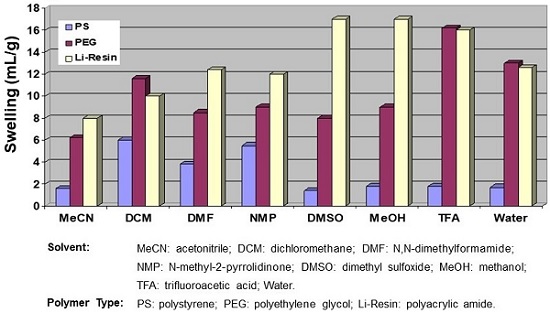Li-Resin, Li-Resin-Primary Amine/Hydroxyl
본문
|
Li-Resin, Li-Resin-Primary Amine/Hydroxyl Li-Resin swells more homogeneously in solvents commonly used for solid phase synthesis and also excellently in aqueous medium.
The swellability profile was determined using common solvents for solid phase synthesis. The results were collected into one graph in comparison with the data of polystyrene (PS) resin and polyethylene glycol (PEG) resin. Unlike the PS resin which is poorly solvated in acetonitrile, DMSO, methanol, trifluoroacetic acid, and water, and unlike the PEG resin which is extremely solvated in trifluoroacetic acid, Li-Resin is more homogeneous among the solvents tested. This is remarkably advantageous for solid phase synthesis because the resin bed of Li-Resin may not expand and shrink dramatically due to the solvent change during a synthesis cycle, providing a more stable and more consistent condition for solid phase synthesis and therefore better quality of the bio-molecule synthesized.
Features; 1. Good mechanical stability for practical loading, easy to handle versus hard to catch for PEG resin as fluffy flakes. 2. Homogeneous swellability in most polar organic solvents. 3. Robust chemical stability against strong acid and strong base. 4. Good swellability in water or aqueous buffers. This is advantageous as chemical manipulation on a bio- molecule can be feasible in aqueous system while the bio-molecule is still attached on the support, and additionally, biochemical applications can be developed such as on-resin screening of chemical libraries and affinity chromatography. 5. The resin is being proven useful for synthesis of bio-molecules with increasing number of peptides successfully synthesized in high quality.
Comparison of Swellability
Li-Resin-Primary Amine 4-(Aminomethyl)piperidine is installed in a cross-linked acrylic amide polymer containing a primary amine reactive group. Amino group is versatile with a variety of reactive counterparts to form a stable covalent bond (1) to install a suitable linker for further assembly of peptide or other bio-molecules or (2) to permanently assemble peptide or other bio-molecule directly on the resin for biological or analytical applications.
Li-Resin-Primary Hydroxyl 4-(Hydroxymethyl)piperidine is installed in a cross-linked acrylic amide polymer containing a primary alcohol active group. Hydroxyl group is versatile with a variety of reactive counterparts to form a covalent bond which can be cleaved by alkaline hydrolysis or ammonolytic detachment from resin.
Amino-Li-Resin—A Fiber Polyacrylamide Resin for Solid-Phase Peptide Synthesis (Article) |
Ordering informations
|
Catalog No. |
Product Name |
Size |
|
Li-Resin-A |
Li-Resin-Primary Amine |
5, 25, 50 & 100g |
|
Li-Resin-H |
Li-Resin-Primary Hydroxyl |
5, 25, 50 & 100g |
▣ 관련 페이지 ; Biotide Core
댓글목록
등록된 댓글이 없습니다.


